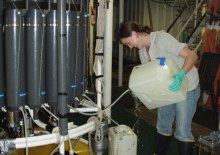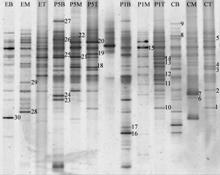
Composition of the plankton community and its contribution to the particle flux in the Sargasso Sea
We are currently funded by NSF-Biological Oceanography to study the contribution of phytoplankton groups to the carbon export at the Bermuda Atlantic Time-Series Station (BATS). We are using a combination of traditional (epifluorescence microscopy, flow cytometry, HPLC) and novel molecular approaches (rRNA gene based Clone Libraries and DGGE fingerprints) to study the phytoplankton communities in the water column and in sinking particles collected by shallow surface tethered traps. The emergence of molecular methods in marine ecological research provides us with the unique opportunity to not only study the diversity of phytoplankton in the water column, but also the microscopically "invisible" plankton contained in the detritus or fecal pellets collected by the traps. The Neuer group participated in the BATS 235 cruise end of May 2008 on the RV Atlantic Explorer; this cruise constituted the first of the 24 monthly cruises from which we will obtain samples for this project.
The ‘biological pump’, the photosynthetically mediated transformation of dissolved inorganic carbon into particulate and dissolved organic carbon in surface ocean waters and its subsequent export to deep water, is a significant driver of the atmospheric carbon uptake by the oceans. But this “biologically pumped” production, inasmuch as it depends on the composition and activity of planktonic organisms, is susceptible to long-term climatic changes in surface ocean properties such as increased temperature and changes in nutrient supply, especially in subtropical gyres. The sub-tropical gyres and the transition zones at their boundaries play an important role in the global carbon cycle because of their vast size and generally high per area export production. As evidenced in recent studies, the biological mechanisms driving regional to basin scale variability in carbon export in these biomes is far from understood, thus limiting our ability to mechanistically explain the biological pump and to predict its possible responses in the face of environmental change. Key to improving this situation is an accurate assessment of the contribution of different plankton groups to overall fluxes.
References:
Amacher J., S. Neuer, I. Anderson and R. Massana. 2009. Molecular approach to determine contributions of the protist community to particle flux. Deep-Sea Research 1. 56, 2206-2215. Doi:10.1016/j.dsr.2009.08.007.







